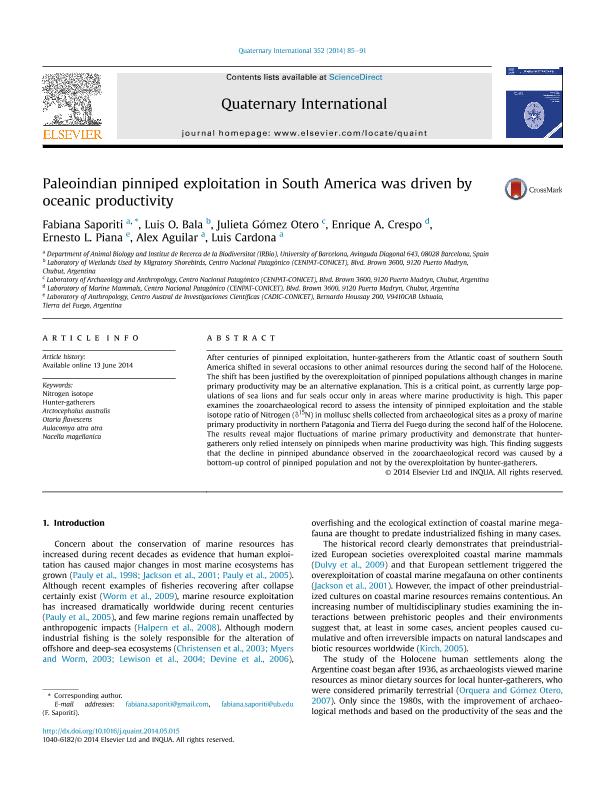Artículo
Paleoindian pinniped exploitation in South America was driven by oceanic productivity
Saporiti, Fabiana; Bala, Luis Oscar ; Gomez Otero, Julieta
; Gomez Otero, Julieta ; Crespo, Enrique Alberto
; Crespo, Enrique Alberto ; Piana, Ernesto Luis
; Piana, Ernesto Luis ; Aguilar, Alex; Cardona, Luis
; Aguilar, Alex; Cardona, Luis
 ; Gomez Otero, Julieta
; Gomez Otero, Julieta ; Crespo, Enrique Alberto
; Crespo, Enrique Alberto ; Piana, Ernesto Luis
; Piana, Ernesto Luis ; Aguilar, Alex; Cardona, Luis
; Aguilar, Alex; Cardona, Luis
Fecha de publicación:
05/2014
Editorial:
Elsevier
Revista:
Quaternary International
ISSN:
1040-6182
Idioma:
Inglés
Tipo de recurso:
Artículo publicado
Clasificación temática:
Resumen
After centuries of pinniped exploitation, hunter-gatherers from the Atlantic coast of southern South America shifted in several occasions to other animal resources during the second half of the Holocene. The shift has been justified by the overexploitation of pinniped populations although changes in marine primary productivity may be an alternative explanation. This is a critical point, as currently large populations of sea lions and fur seals occur only in areas where marine productivity is high. This paper examines the zooarchaeological record to assess the intensity of pinniped exploitation and the stable isotope ratio of Nitrogen (d15N) in mollusc shells collected from archaeological sites as a proxy of marine primary productivity in northern Patagonia and Tierra del Fuego during the second half of the Holocene. The results reveal major fluctuations of marine primary productivity and demonstrate that huntergatherers only relied intensely on pinnipeds when marine productivity was high. This finding suggests that the decline in pinniped abundance observed in the zooarchaeological record was caused by a bottom-up control of pinniped population and not by the overexploitation by hunter-gatherers.
Archivos asociados
Licencia
Identificadores
Colecciones
Articulos(CADIC)
Articulos de CENTRO AUSTRAL DE INVESTIGACIONES CIENTIFICAS
Articulos de CENTRO AUSTRAL DE INVESTIGACIONES CIENTIFICAS
Articulos(CCT-CENPAT)
Articulos de CTRO.CIENTIFICO TECNOL.CONICET - CENPAT
Articulos de CTRO.CIENTIFICO TECNOL.CONICET - CENPAT
Citación
Saporiti, Fabiana; Bala, Luis Oscar; Gomez Otero, Julieta; Crespo, Enrique Alberto; Piana, Ernesto Luis; et al.; Paleoindian pinniped exploitation in South America was driven by oceanic productivity; Elsevier; Quaternary International; 352; 5-2014; 85-91
Compartir
Altmétricas



